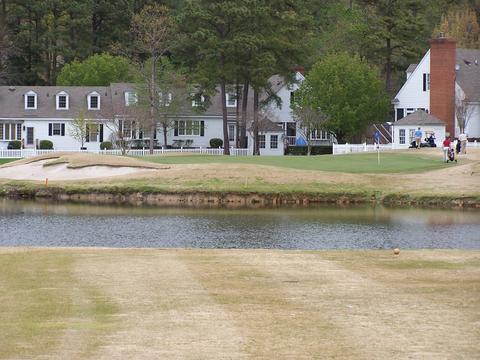Yesterday I noted that I have lost significant distance off the tee since last year, maybe 20 yards, and I am about one club shorter with my irons. I know it is the lack of shoulder turn, the result largely of advancing age and sedentary habits. Still, I had my best score of the year on the back nine at Ford's Colony's Blue Heron course in Williamsburg, so the logical conclusion is that the course was easy.
Dan Maples designed the Blue Heron as well as the two other 18s at Ford's Colony, the Black Heath and the Marsh Hawk. None of the ratings from the men's tees exceed 70.0 and the highest slope rating is 125 (the Blue Heron is 124 at 6,328 yards). I like Maples courses, but his designs do seem geared to "vacationers." (Who wants stress on a vacation?) The Blue Heron, which featured some nice elevation changes, fairly slick and smooth greens, and just enough in-play water to keep some adrenaline pumping, was the right medicine to boost my ego with a decent score. But I am not sure this, or its companion courses at Ford's Colony, would satisfy me day in and day out while I still pretend I am the golfer I once was.
Those of us contemplating retirement to a golf-oriented lifestyle face a dilemma: Will the course we choose to play a few times a week pose enough of a challenge or too much of one? At the brutally tough Davis Love III course in Chapel Hill, The Preserve at Lake Norman, breaking 80, for a 10-handicap golfer, would be a thrill; but the thrills would be far and few between. I also have played a course in eastern Tennessee, at Rarity Bay, that was so forgiving that the thrill was gone by the end of one round.
The Blue Heron tended a little toward the easy side, but in five years, who knows? It might be all the challenge I would want, and then some. So in choosing a community and its adjacent golf course(s), do we make the big investment based on our game today or the one we project for ourselves a few years out? My own theory is that many of us will have it both ways, moving a few times in retirement for a number of reasons, not the least to rehab our scores on courses more suited to our then-current game. As the generational psychologists like to say, baby boomers want what they want.
Last night's dinner was at a local Vietnamese restaurant called Chez Trinh. The "Chez" part is a little frilly, since there are no combo French/Viet dishes on the menu, but the food was serious, ample and quite tasty. The crab and asparagus soup was the real thing, not those ubiquitous, imitation and unfortunately named sea legs, but real shredded crab. The white asparagus may have come out of a can, but the half dozen pieces held their own in the silky broth. The rice paper that enclosed pieces of garlic pork, mint leaves and bean sprouts was a bit spongy, and the pork seemed a little past its prime, but the mint gave the dish a refreshing kick.
The Saigon Seafood plate announced itself just as the kitchen door opened, a sizzling - almost howling - dish that included small shrimp, the oxymoronic large shrimp, and scallops, as well as a heady dose of ginger. Well-prepared Vietnamese food depends on the freshest ingredients, and this dish did not disappoint.
Later today I play the River Course at Kingsmill, which Pete Dye renovated a couple of years ago. Stay tuned.

The 17th on the Blue Heron at Ford's Colony is not as tough as it appears. That bank in front of the pin is not steep and you can land just short of the green without fear of rolling into the water. However, the pin position indicator -- halfway up the stick -- was wrong. The pin was at front on a very deep green, and I hit way too much club.



